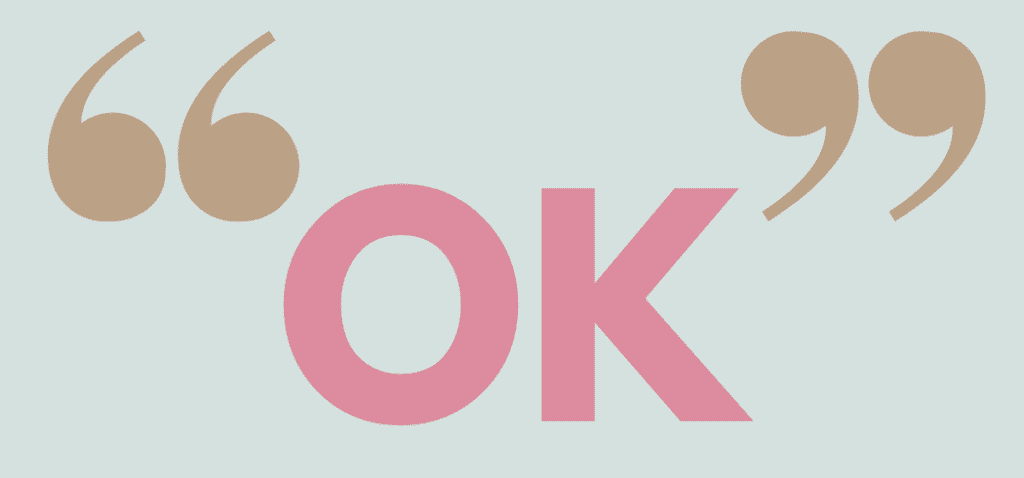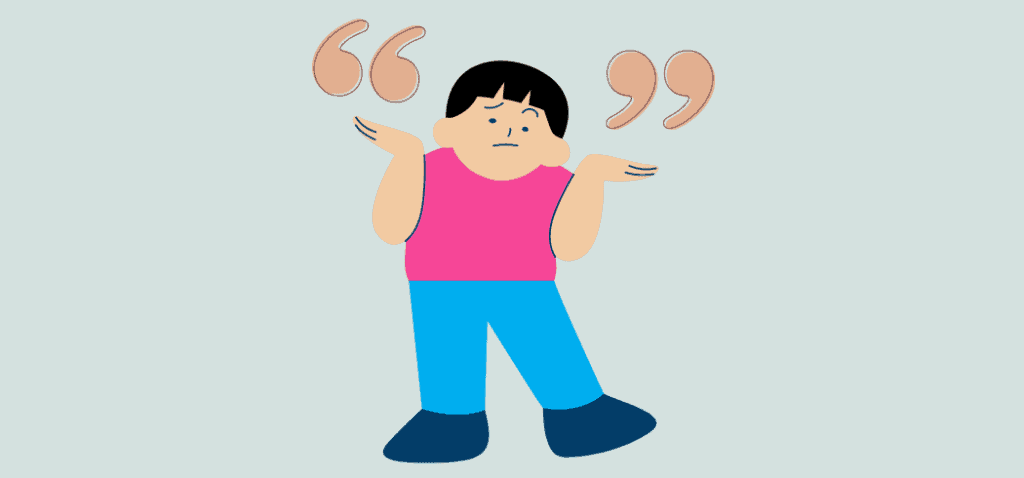Quotation mark use is specific to both direct and indirect forms of support to help prove ideas and arguments. We also use them in dialog to help make stories more interesting.
However, using them requires knowing some very specific rules, especially concerning punctuation. Take a look at the particular ways you can use them to bring further understanding to your writing and ensure they are grammatically correct.
What Are Quotation Marks?

Quotation marks are punctuation marks used to begin and end quotations. They are either a double quotation mark (“and”) and used to enclose a full quotation, or a single quotation mark (‘and’) and are used to enclose a quote within a quote (also called closing quotation marks). In British English, the reverse is true, but this article is focused specifically on the American English method.
Quotation Mark Rules with Examples
Quotations help provide interest and signify dialog and support to an argument by using somebody else’s words in your writing. It is essential to understand the different quotes you can use and which one requires quotation marks.
Direct Quotations
A direct quotation requires double-quote marks representing a person’s exact words, speech, or thoughts. These can be presented as an uninterrupted sentence or as a phrase within another complete sentence.
For Example:
- “The past is but the beginning of a beginning.” – H. G. Wells
- The famous author, H. G. Wells, offered philosophical musings in his writing, such as his statement of “the past [being] but the beginning of a beginning.”
You can also use introductory, conclusion, or interrupting expressions with quotations.
For Example:
- H. G. Wells wrote, “the past is but the beginning of a beginning.”
- “The past is but the beginning of a beginning” was written by H. G. Wells.
If you are using a quote between quotation marks, use the single-quote mark to avoid confusion. This single mark within quotation marks use infers the subject’s exact words.
For Example:
- The professor wanted to ensure her readers were aware of the studies surrounding H.G. Wells and “his invested interest in ‘social issues and political proceedings’ of the time in which he wrote his books”.
Indirect Quotations
Indirect quotes do not require quotation marks as they report only the general meaning of what a person said or thought through paraphrasing. An indirect quote rephrases somebody else’s words but is not the exact words being quoted.
For Example:
- H. G. Wells philosophized that a new beginning was born of past events.
Quotation Marks and Titles
If you are mentioning a title within a sentence, you must indicate it is a title through the use of either quotation marks or italics. The decision to use these is dependent upon the types of titles you are using.
If you are using a short work, you must include quotation marks. Longer works require italicization. For example, you would place a song title within quotations but italicize the album name.
You can do the same thing with the titles of books. Be sure to check which style guide you may be following, however (i.e. MLA vs. APA). Guides often provide specific use of quotations or italics pertaining to titles.
Quotation Marks and Rules of Punctuation
When you insert quotes and dialog into text, you need to punctuate it correctly. What to capitalize and when, as well as where punctuation marks belong, can become confusing. Pay attention to the following rules to correctly use quotations.
Rule #1
The first word of a quote is capitalized only when it falls at the beginning of a sentence (or is a proper noun).
For Example:
- In writing about social issues, Kurt Vonnegut, Jr. called high school as being “closer to the core of the American experience than anything else.”
- “High school is closer to the core of the American experience than anything else I can think of” wrote Kurt Vonnegut, Jr. when asked about current social issues.
Rule #2
Use a comma or colon after using introductory expressions.
For Example:
- Kurt Vonnegut, Jr. wrote, “high school is closer to the core of the American experience than anything else I can think of.”
If you use the he-said/she-said expression to show who is speaking the quote, or if a formal tone is taken, use a colon instead of a comma before the quotation.
For Example:
- The professor addressed the class: “Today, we will discuss Kurt Vonnegut, Jr.’s Slaughterhouse-Five.”
Rule #3
Use a comma, question mark, or exclamation mark after a quoted sentence when followed by a concluding expression.
For Example:
- “High school is closer to the core of the American experience than anything else I can think of,” wrote Kurt Vonnegut, Jr.
Rule #4
Use a comma after part of a quoted sentence when followed by an interrupting expression. Then, use a comma after the expression.
For Example:
- “High school is closer to the core of the American experience,” wrote Kurt Vonnegut, Jr., “than anything else I can think of.”
Rule #5
Use a comma, question mark, or exclamation mark after quotations that come before an interrupting expression. Then, use a period after the expression.
For Example:
- “What does writing teach?” Ray Bradbury asked. “First and foremost, it reminds us that we are alive.”
Commonly Asked Questions Concerning Quotation Mark Use

To help further clarify the rules above, commonly asked questions concerning quote use are addressed below.
Why Use Quotation Marks Around a Single Word?
When quotations are used around a single word, this often either emphasizes a specific term used by another person or distances the author from the word and highlights an ironic use. It implies the author may disagree with the use of the word.
Does a Period Belong Inside or Outside Quotes?
In American English, the period always goes inside the quotation marks. It is proper to place it outside the quotation marks in British English.
Does a Comma Belong Inside or Outside Quotes?
In American English, commas always go inside the quotation marks. It is proper to place it outside the quotation marks in British English.
How Do You Use Block Quotations?
Block quotes are defined as those that are longer than four lines of prose or three lines of poetry. It is used when quoting dialog and serves as a freestanding quote that does not include quotation marks.
For Example:
- In Wuthering Heights, Nelly actively dehumanizes Heathcliff, and views him as inferior:
They entirely refused to have it in bed with them, or even in their room, and I had no more sense, so, I put it on the landing of the stairs, hoping it would be gone on the morrow. By chance, or else attracted by hearing his voice, it crept to Mr. Earnshaw’s door, and there he found it on quitting his chamber. Inquiries were made as to how it got there; I was obliged to confess, and in recompense for my cowardice and inhumanity was sent out of the house.
How to Use Quotes in a Sentence?
See the following examples to help you address the rules explained above:
- Proclaiming the friendship “wonderful,” Sarah was confident it would continue.
- During the Winter Carnival, Finny stands up on the table to dance with the “wildest demonstration of himself” to show the others “his choreography of peace.”
- Mrs. Wilmot “always felt the center of heart go hard” when her children were present, but to the rest of the world, she appears to be a loving mother.
- The war was not immediate to the boys. “Bombs in Central Europe,” said Gene, “were completely unreal to us here…because our place here was too fair for us to accept something like that.”
- “It was,” asserted Robert, “a night made for hard thoughts.”
Unnecessary Quotation Mark Use
The unnecessary use of quotation marks is a sign of amateurish writing. In business writing and poorly written web articles, some writers use quotation marks to give emphasis.
For Example:
- Most people already know full well that proper diet and exercise is the way to lose weight, and yet so many find themselves helpless to do what they know they “should” be doing.
Some writers put unnecessary quotation marks around expressions or common phrases.
For Example:
- Be patient and “roll with the punches.”
When change comes it is best if we “get with the program” [iSnare]
And some writers use quotation marks for phrasal adjectives that should be hyphenated.
For Example:
This “back to the basics” [back-to-the-basics] approach resonated with fans and critics alike. [Pop Matters]
Fans of the “everything and kitchen sink” [everything-and-kitchen-sink] approach will love this offering from Panasonic. [Hub Pages]
Let’s Review
Using quotation marks is necessary whenever you directly use somebody else’s words in your writing. It helps provide the reader context and ownership of the thoughts and support for your own written musings and arguments.
Be sure to attend to proper punctuation and capitalization use for grammatical purposes and reader understanding. Using the simple rules and examples above can help you integrate your quotes correctly into sentences.
